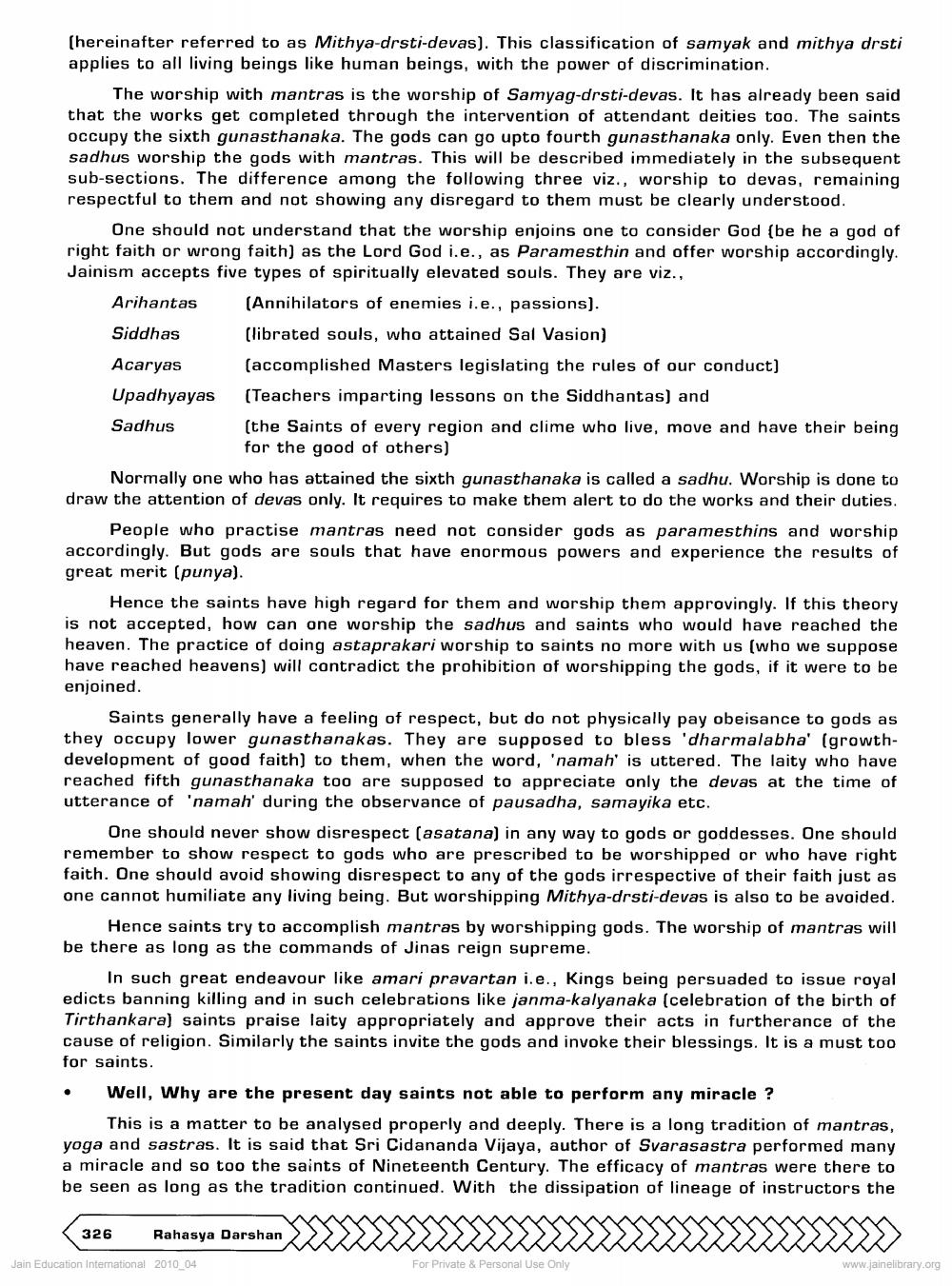________________
(hereinafter referred to as Mithya-drsti-devas). This classification of samyak and mithya drsti applies to all living beings like human beings, with the power of discrimination.
The worship with mantras is the worship of Samyag-drsti-devas. It has already been said that the works get completed through the intervention of attendant deities too. The saints occupy the sixth gunasthanaka. The gods can go upto fourth gunasthanaka only. Even then the sadhus worship the gods with mantras. This will be described immediately in the subsequent sub-sections. The difference among the following three viz., worship to devas, remaining respectful to them and not showing any disregard to them must be clearly understood.
One should not understand that the worship enjoins one to consider God (be he a god of right faith or wrong faith) as the Lord God i.e., as Paramesthin and offer worship accordingly. Jainism accepts five types of spiritually elevated souls. They are viz.,
Arihantas
(Annihilators of enemies i.e., passions].
Siddhas
Acaryas
Upadhyayas
Sadhus
Normally one who has attained the sixth gunasthanaka is called a sadhu. Worship is done to draw the attention of devas only. It requires to make them alert to do the works and their duties.
(librated souls, who attained Sal Vasion)
(accomplished Masters legislating the rules of our conduct]
[Teachers imparting lessons on the Siddhantas) and
(the Saints of every region and clime who live, move and have their being for the good of others)
People who practise mantras need not consider gods as paramesthins and worship accordingly. But gods are souls that have enormous powers and experience the results of great merit (punya).
Hence the saints have high regard for them and worship them approvingly. If this theory is not accepted, how can one worship the sadhus and saints who would have reached the heaven. The practice of doing astaprakari worship to saints no more with us (who we suppose have reached heavens) will contradict the prohibition of worshipping the gods, if it were to be enjoined.
Saints generally have a feeling of respect, but do not physically pay obeisance to gods as they occupy lower gunasthanakas. They are supposed to bless 'dharmalabha' (growthdevelopment of good faith) to them, when the word, 'namah' is uttered. The laity who have reached fifth gunasthanaka too are supposed to appreciate only the devas at the time of utterance of 'namah' during the observance of pausadha, samayika etc.
One should never show disrespect (asatana) in any way to gods or goddesses. One should remember to show respect to gods who are prescribed to be worshipped or who have right faith. One should avoid showing disrespect to any of the gods irrespective of their faith just as one cannot humiliate any living being. But worshipping Mithya-drsti-devas is also to be avoided.
Hence saints try to accomplish mantras by worshipping gods. The worship of mantras will be there as long as the commands of Jinas reign supreme.
In such great endeavour like amari pravartan i.e., Kings being persuaded to issue royal edicts banning killing and in such celebrations like janma-kalyanaka (celebration of the birth of Tirthankara) saints praise laity appropriately and approve their acts in furtherance of the cause of religion. Similarly the saints invite the gods and invoke their blessings. It is a must too for saints.
Well, Why are the present day saints not able to perform any miracle ?
This is a matter to be analysed properly and deeply. There is a long tradition of mantras, yoga and sastras. It is said that Sri Cidananda Vijaya, author of Svarasastra performed many a miracle and so too the saints of Nineteenth Century. The efficacy of mantras were there to be seen as long as the tradition continued. With the dissipation of lineage of instructors the
326
Rahasya Darshan
Jain Education International 2010_04
For Private & Personal Use Only
www.jainelibrary.org




